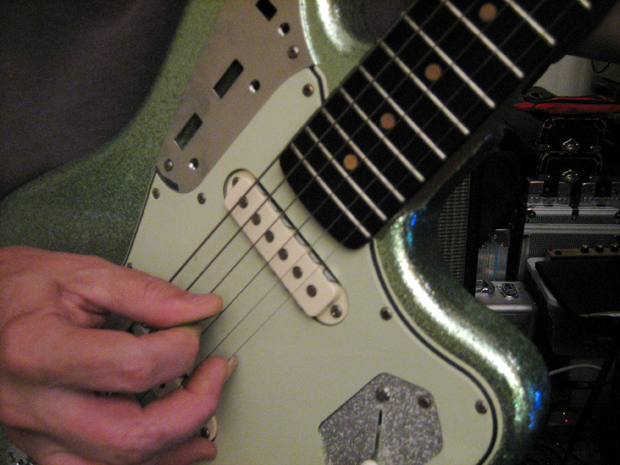Add Some Color to Your Sound with This Fake 12-String Guitar Technique

A while back, I was thinking about the sound of a 12-string guitar, and how much I liked it, but really would like to hear it used on only certain notes and melodic lines within a song.
When you're recording, you can use all kinds of exotic instruments for embellishing sections of a song.
But you probably would like to be able to recreate your recorded performance live. It would be cool to be playing something on a six-string and have certain notes of the melody jump out with a 12-string sound and attack.
I like to use a flat pick held with the thumb and first finger, and use the middle finger for the high-octave sound. This is a good start for rock guitar players to get into branching out into some new sounds and adding some color. You're also in position to play rockabilly-style alternating bass notes on the fly within your rock riffing.
The 12-string sound works well with all types of amp sounds, from clean to high gain. It works well with a high gain sound because octaves are "perfect" intervals. An example: "A" is 440 cycles per second, and an octave up from that is 880 cycles per second.
It really helps to grow your fingernails out a bit, so the sound of the octave can sound the same as the picked note, and you can get some nice-sounding attack. I've become so dependent on the sound of this technique, that now, certain songs I write cannot be played without this sound.
So to help insure that I could make it through a tour without breaking a nail, and not sound like I'm making a lame excuse for not playing certain songs, I go to manicure shops to get a clear, hard coating put onto just my middle and third fingernails. You rockabilly cats are probably already doing this!
Give this an honest try, and I think you will be rewarded by the results. To get into this, start with this descending melody. This is in the key of C, starting and ending on G. Some of the fingering may seem odd, but doing it as I've written it helps to make smooth transitions possible:
Here it is, changing notes on 1/4 notes:
Here it is, half-time:
- Fretted G on the first string, third fret, use third finger ~ Open G on third string
- Fretted F on the first string, first fret, use first finger ~ Fretted "F" on fourth string, third fret, use middle finger
- Open E on first string ~ Fretted E on fourth string, second fret, use middle finger
- Fretted D on second string, third fret, use third finger ~ Open D on fourth string
- Fretted C on second string, first fret, use first finger ~ Fretted C on fifth string, third fret, use middle finger
- Open B on second string ~ Fretted B on fifth string, second fret, use middle finger
- Fretted A on third string, second fret, use middle finger ~ Open A on fifth string
- Open G on third string ~ Fretted G on sixth string, third fret
Then try going up using the same fingering as you did going down:
Here's an example of how I used this technique in one of my songs, "Bird Bone," from the album Into The Blue Sparkle by my band, Slacktone:
Fake Twelve String Effect 4 - "Bird Bone"
Guitarist Dave Wronski is one third of Slacktone, a Southern California-based modern surf band that has toured the world and elsewhere. He also has written and recorded music for TV-show themes, commercial soundtracks and films.
"Bird Bone" © Dave Wronski, Slacksong Music BMI
Get The Pick Newsletter
All the latest guitar news, interviews, lessons, reviews, deals and more, direct to your inbox!







![Joe Bonamassa [left] wears a deep blue suit and polka-dotted shirt and plays his green refin Strat; the late Irish blues legend Rory Gallagher [right] screams and inflicts some punishment on his heavily worn number one Stratocaster.](https://cdn.mos.cms.futurecdn.net/cw28h7UBcTVfTLs7p7eiLe.jpg)


